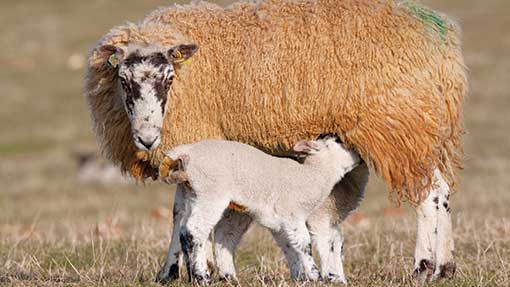Better hygiene can prevent sheep losses due to mastitis

New research suggests mastitis in sheep is potentially a bigger problem than initially thought. Gemma Claxton reports
Farmers are being urged to improve hygiene at lambing to reduce mastitis risk, after research revealed 10% of the national flock were culled due to the condition.
Speaking at a recent EBLEX event, researcher Laura Green of Warwick University, said although clinical cases on a sample of 400 farms were frequently less than 7%, she would expect the actual number of subclinical cases to be much higher.
“Seeing sick sheep is just the tip of the iceberg, there is lots more mastitis going on unseen in the flock,” said Prof Green.
Subclinical mastitis may have no signs at all, other than a raised immune response only detectable through an increased somatic cell count (SCC) in milk. It often goes unnoticed until checks at weaning, where lumps and swellings may be found, but by which point the associated reduced milk production has already affected lamb growth rates.
Causes
Prof Green said one of the biggest ways farmers could reduce mastitis cases was by preventing teat lesions. “Teat lesions allow bacteria to enter the area of damaged skin. The lesions are often caused by bites, tears and grazes, and occur because of the way the lamb latches on to the teat or during prolonged feeding,” she said.
A study of 67 sheep and lambs on a West Midlands farm, showed teat position to have the biggest impact on the presence of lesions. Prof Green reported the ideal teat positions were angled at four o’clock and eight o’clock. Teats in any other position resulted in a fivefold increase in lesions, due to the lamb suckling at an odd angle.
“Anecdotal evidence suggests that mastitis is creeping into pedigree flocks because of the way breeders are selecting for horizontal teats in Europe. Breed societies are considering putting udder shape in their selection criteria and some people are already trying to breed out mastitis susceptible lines,” she said.
Farmers breeding their own replacements were advised by Prof Green to select for correct teat position, a tight udder and no mastitis. Those buying in ewes and rams need to ensure there is no history of mastitis.
“Genetics isn’t ‘the’ solution for mastitis, but it’s part of a package,” she said.
Two-year-old ewes were also three-and-a-half times more likely to have traumatic lesions in comparison to six-year-old ewes. Prof Green put this down to the slow development of mammary tissue in first-time lambers.
“Lambs have to spend longer feeding from ewe lambs, gimmers or shearlings, causing friction, frustration and more risk of the lamb butting and biting. Young ewes with twins take considerably longer.”
Prof Green advised farmers to consider leaving only one lamb on all first-time lambers, particularly ewe lambs as they are still growing. “This will reduce suckling time per teat as the lamb can feed from both halves alternately, lowering demand on the immature udder. The other twin could be adopted or artificially reared,” she added.
She also said feeding ewes appropriately so they were in a fit condition would allow the ewe to feed the lambs well. “Some farmers feed ewes after lambing until four weeks post-lambing. This is the worst time to stop supplementary feeding as lamb demand for milk is at its highest,” said Prof Green.
Prevention
Prof Green also blamed humans as a major infection source for mastitis, and urged farmers to wear gloves and wash hands after lambing a ewe and before touching the udder.
“Those that strip out both halves with an arm that’s been in the bacteria-filled vagina and squirt milk all over the bedding are creating a recipe for spreading mastitis. Wear clean overalls, wash boots daily and strip out each half into a container,” she added.
Lambs may also pick up and spread bacteria causing mastitis, but separating mastitic ewes avoids cross suckling, which hungry lambs will do due to lowered milk production.
She also suggested maintaining a dry bed by adding fresh straw daily and using lime or a powdered disinfectant in lambing pens to prevent mastitis spread.
Treatment
- Works best if caught early (warning signs include hanging back from food, seeking isolation, kicking lamb off)
- Blind trial showed no preferred antibiotic
- Pain relief (anti-inflammatory) is as important
- Milk out the ewe carefully and dispose of highly infected milk
Watch a suite of lambing ‘how to’ videos
